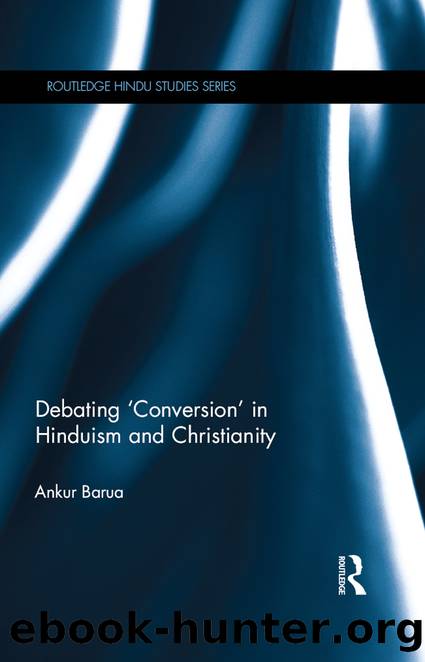Debating 'Conversion' in Hinduism and Christianity by Barua Ankur

Author:Barua, Ankur
Language: eng
Format: epub
ISBN: 978-1-317-53858-5
Publisher: Taylor & Francis (CAM)
Speaking for the convert
In short, the key question which underlies these complex issues seems to be this: ‘who speaks for the convert?’, one which parallels the question that has been intensely debated in the area of subaltern studies, ‘who speaks for the subaltern?’ The charge that the voices of the subaltern classes such as the peasants are marginalised in elitist versions of history, which centre around the activities of only the British administrators and the native elites, seems to have an interesting parallel in our observation in the previous sections that the agential capacities of the converts are often denied in certain accounts of their conversions to Christianity. It can be argued that converts to Christianity, whether from the ‘higher’ or the ‘lower’ castes, exhibited varying degrees of subalternity vis-à-vis the British colonial regime, the Christian missionaries and the Hindu nationalists. We have noted that the missionaries sometimes found themselves in subaltern locations relative to the British administrators, and the ‘lower’ castes even more so with respect to the former. Therefore, arguing that missionary studies can be regarded as an instance of ‘subaltern studies’, J. C. Ingleby remarks:
Let us by all means ‘deconstruct’ a history of the times which suggests that only the rich and the powerful are the makers of history, and that the consciousness of every subordinate group can only be defined by the rich and the powerful. But this means that we must allow the missionaries, too, to make their own history, and not just the missionaries, but the Indian Church that they struggled to bring into being.
(Ingleby 2000: xvii–xviii)
However, as we will point out, both ‘postpostcolonial’ missionary studies and subaltern studies – which seek to retrieve native agency from official histories – share not only certain parallels but also certain paradoxes.
Scholars of subaltern studies seek to provide alternative contestatory readings of the colonial pasts through the excavation of historical documents which were largely the products of the elites, such as the British administrators, bureaucrats, and Indian nationalist personalities. Ranajit Guha (1982: 1–8) criticises ‘elitist historiography’ for its assumption that it was the British administration with its institutions and bodies such as the Indian National Congress which established the functional constraints for the domain of Indian political engagement, for this leads to the conclusion that politics is to be equated with the activities of only those who were located in these bounds. However, a conundrum that subaltern historians have tried to grapple with in their self-reflexive moments is the question of whether or not they have fallen into the same trap that they have accused nationalist historians of having become immured in. That is, whether or not in trying to recover the voices silenced by the dominant modes of discourse they are subtly appropriating the subalterns into their historical projects and claiming to speak on their behalf by filling up the empty spaces, negations, and absences. As Ania Loomba reminds us, it has not been easy ‘to maintain a balance between ‘positioning’ the subject and amplifying his/her
Download
This site does not store any files on its server. We only index and link to content provided by other sites. Please contact the content providers to delete copyright contents if any and email us, we'll remove relevant links or contents immediately.
| African-American Studies | Asian American Studies |
| Disabled | Ethnic Studies |
| Hispanic American Studies | LGBT |
| Minority Studies | Native American Studies |
Cecilia; Or, Memoirs of an Heiress — Volume 1 by Fanny Burney(31320)
Cecilia; Or, Memoirs of an Heiress — Volume 3 by Fanny Burney(30927)
Cecilia; Or, Memoirs of an Heiress — Volume 2 by Fanny Burney(30884)
The Great Music City by Andrea Baker(21138)
We're Going to Need More Wine by Gabrielle Union(18063)
Bombshells: Glamour Girls of a Lifetime by Sullivan Steve(13098)
Pimp by Iceberg Slim(12922)
All the Missing Girls by Megan Miranda(12739)
Fifty Shades Freed by E L James(12442)
Norse Mythology by Gaiman Neil(11870)
Talking to Strangers by Malcolm Gladwell(11855)
Crazy Rich Asians by Kevin Kwan(8340)
Mindhunter: Inside the FBI's Elite Serial Crime Unit by John E. Douglas & Mark Olshaker(7825)
The Lost Art of Listening by Michael P. Nichols(6460)
Enlightenment Now: The Case for Reason, Science, Humanism, and Progress by Steven Pinker(6402)
Bad Blood by John Carreyrou(5760)
The Four Agreements by Don Miguel Ruiz(5501)
Weapons of Math Destruction by Cathy O'Neil(5027)
We Need to Talk by Celeste Headlee(4860)
